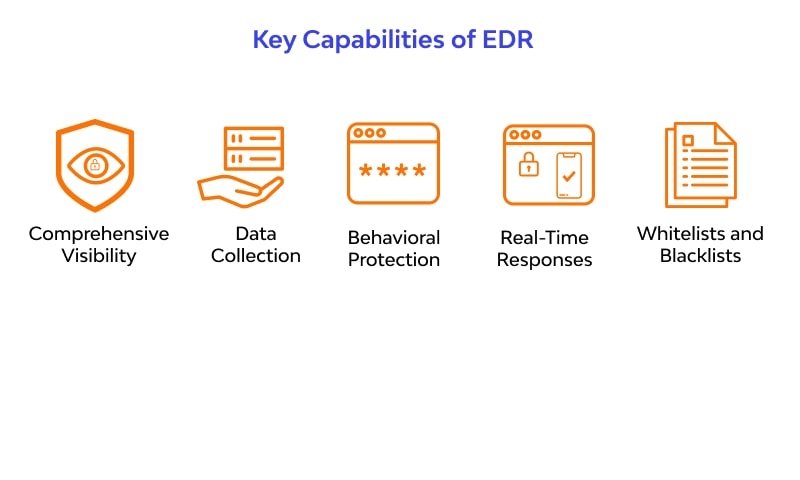Updated on July 12, 2023, by OpenEDR
This article will discuss endpoint detection and response (EDR), why it’s so crucial in today’s cybersecurity, the most typical problems that arise during deployment, and the best ways to avoid them. Get comfortable because we’re about to embark on a journey to learn how EDR security meaning can completely transform the security infrastructure of your business.
What Does EDR Security Meaning?
Proactively detecting, investigating, mitigating, and responding to advanced threats targeting endpoints within an organization’s network is the goal of Endpoint Detection and Response (EDR security meaning), a cybersecurity solution. Computers, laptops, servers, mobile devices, and anything else that can access a network are all examples of endpoints.
To detect new or zero-day malware,
meaning uses cutting-edge approaches, including behavioral analysis and machine learning algorithms, as opposed to the signature-based detection used by typical antivirus software.
Whenever an endpoint is connected to an EDR solution, it begins collecting data about the processes operating on that endpoint. File-access histories, user/application modifications, new network endpoint connections, and more fall under this category of information.
EDR Definition: EDR security means businesses quickly detect malicious behavior and respond effectively before significant damage is caused by combining this comprehensive visibility into endpoint activities with threat intelligence feeds from various sources like global security databases and sandboxing technology for dynamic analysis of suspicious files.
EDR Security Meaning: Common Challenges in Implementing EDR
EDR security means that aligns with your organization’s requirements.
implementing Endpoint Detection and Response (EDR security meaning) technologies. By being aware of these typical roadblocks, businesses will be better prepared to deal with them throughout implementation.
Choosing an EDR system that works for your company is a significant task. It can be difficult to find an effective EDR solution that meets all of your needs and helps you achieve your security objectives in a market filled with so many competing products. Making this choice will be less difficult if you do your homework and talk to professionals.
Another difficulty is making sure EDR security-meaning tools work with the current network setup. When trying to incorporate an EDR solution with existing security systems inside an organization, compatibility concerns may develop. Preliminary compatibility testing is essential for preventing disruptions and disagreements.
In addition, it is crucial but often forgotten during deployment, to define explicit policies and workflows for incident response. Team members may not know how to appropriately respond to threats or incidents reported by the EDR security meaning if there are no clearly established processes in place.
Organizations also face substantial obstacles from factors including limited budgets and a lack of experienced employees when attempting to install EDR systems. Investments in both time and money from committed employees who can make the most of the available technology are necessary for effective EDR security meaning plan deployment.
Organizations can more easily overcome barriers during the implementation of endpoint detection and response systems if they are aware of and prepared for these frequent challenges ahead of time and apply best practices adapted to their individual circumstances.
Best Practices for Implementing EDR Security meaning
When it comes to implementing Endpoint Detection and Response (EDR security meaning) in your organization, there are several best practices that can help ensure a successful deployment. Consider these important tips:
- Assess Your Organization’s Needs: Before diving into the implementation process, assess your organization’s specific security needs. Understand what types of threats you face and the level of protection required.
- Choose the Right Solution: Select an EDR security meaning that aligns with your organization’s requirements. Look for features such as real-time monitoring, threat intelligence integration, and incident response capabilities.
- Plan Ahead: Develop a comprehensive implementation plan that outlines timelines, resource allocation, and communication strategies. This will help ensure a smooth deployment process.
- Train Your Team: Provide adequate training to both IT personnel and end-users on how to effectively use the EDR security meaning. This will empower them to identify and respond to potential threats promptly.
- Regularly Update and Patch: Keep your EDR solution up-to-date with the latest software patches and updates from the vendor. This helps address any vulnerabilities or weaknesses in the system.
- Monitor Effectively: Establish clear guidelines for monitoring alerts generated by the EDR security meaning solution so that potential threats can be swiftly identified and addressed.
Remember that implementing EDR security meaning is an ongoing process rather than a one-time event – regularly evaluate its effectiveness through continuous testing/assessment exercises while adapting it according to evolving threat landscapes.
Conclusion – EDR Security Meaning
An integral part of any cutting-edge security system is the capacity to identify and counteract threats at the endpoint. Knowing the many potential issues that can develop during EDR security meaning implementations, can help businesses better satisfy their own demands. The best practices that assist firms in safeguarding their networks and data in real-time include automatic endpoint scanning, incident response strategies, employee awareness training, and continuous monitoring systems.
Related Resources:
EDR Definition
